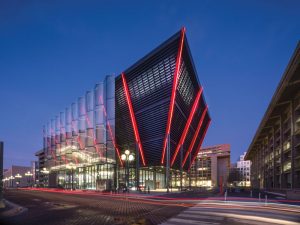Designed by renowned architects Rogers Stirk Harbour + Partners, and local architects Hickok Cole, the International Spy Museum at L’Enfant Plaza in Washington, DC, is a 130,000-square-foot, distinctively designed steel building with museum exhibition, office, retail, classroom, and event spaces. The project site at L’Enfant Plaza was chosen in part to create a pedestrian connection between the National Mall and the newly developed Southwest Waterfront in downtown Washington, DC.
The building’s innovative design incorporates exposed, “L-shaped” red-painted columns constructed from grade 50 steel plates along the south and west faces that slope at an angle of approximately 2.5-vertical:1-horizontal and are part of the building’s gravity load-carrying system. Columns taper and have reduced depths at the top, where structural demand diminishes, to reduce material cost and for aesthetics. The entire building was designed as a space frame with floor beams and their connections able to resist in-plane forces in addition to shear connection forces to achieve the architectural intent of not continuing the sloping columns to the ground.

SK&A was an Outstanding Award Winner for the International Spy Museum project in NCSEA’s 2020 Annual Excellence in Structural Engineering Awards Program in the Category – New Buildings $80M to $200M.
The red-sloping columns and their connections to the primary building structure are entirely exposed to view. An innovative connection was developed where the flanges of the steel floor beams were coped just inboard of the facade, the beam webs were reinforced and extended through the façade, and the beams and sloping columns were connected with 1½-inch-diameter slip critical A490 bolts. This provided gravity support for the floors while also providing bracing points for the sloping red columns. All members are Architecturally Exposed Structural Steel (AESS) and intumescent painted. A full-scale mock-up of this connection at level 04 was built and reviewed in the steel fabricator’s shop early in the design phase to ensure structural and aesthetic compliance.
The typical museum floor construction is composite steel beams with concrete on metal deck. RAM Steel and FloorVibe were used to size steel beams for strength and serviceability, and vibrational performance was carefully considered due to the 55½-foot beam spans. Also, duct openings through beam webs were coordinated with the design team to maximize ceiling heights.
The sloping geometry of building columns at the south and west faces causes an inherent lateral drift from gravity loads. Further compounding this issue, museum programming prevented the placement of traditional braced frames near the sloping south and west building faces, resulting in significant diaphragm torsion. Full story-depth “hat trusses” were placed above the highest museum level within the mechanical plant in line with primary building core braced frames to help address these issues. A three-story, sloping braced frame that is discontinuous to ground was used at the south edge, located just inboard of the façade, to avoid intrusion on museum space. During construction, SK&A worked closely with the contractors to establish a construction sequence to limit lateral building drifts due to the unbalanced sloping nature of the west and south building faces.
A glass veil lines the west edge of the building and is supported with gravity and lateral connections attached directly to the sloping red columns. Within the space of the glass veil, there is an intricate series of monumental stairs and platforms constructed from AESS members of varying shapes and profiles, all of which had expressed connections to the built-up AESS building columns. Steady-state analysis with SAP2000 was conducted to evaluate the vibrational performance of the entire system.
An events space is located at level 07, which includes a 23-foot cantilever protruding above the roadway below to provide striking views of the Capitol Building. A combination of cantilevered beams, perimeter built-up steel box beams for torsional rigidity, and 3-inch-diameter stainless steel diagonal tension rods were used to alleviate vibrational concerns for potential rhythmic excitations.
Due to existing site constraints, the eastern column line of the new museum does not align with the existing columns below. The structural solution for this was to construct post-installed concrete transfer girders beneath the existing concrete slab, which bear on new concrete jackets at the existing columns. Three-dimensional finite element modeling with ETABS and SAP2000 was conducted to analyze the effects of these transfer conditions on the core braced frame designs and overall lateral building drifts.
The museum structure is built on top of an existing four-story concrete structure containing retail, government space, and parking, which remained active and occupied throughout construction. Existing concrete columns were strengthened with post-installed concrete jackets. Unique column jackets were designed on a case-by-case basis to minimize disruptions to existing spaces below.
The existing spread footings were not adequate to support new loads and needed to be strengthened. Micropiles were expensive, especially given the site constraints, and so spread footing enlargements were designed wherever possible based on structural demand and soil properties. Where required due to large loads, hollow-core micropiles approximately 50 feet in length were used.
This distinctively designed steel building is a beacon for its museum, event, retail, office, and instructional spaces along the Southwest Waterfront. As the major draw, the museum is tailored to present state-of-the-art exhibits and installations to promote public understanding of intelligence and espionage.■
